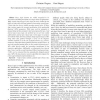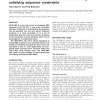6719 search results - page 75 / 1344 » A Generalization of Automatic Sequences |
EUSFLAT
2009
13 years 6 months ago
2009
Fuzzy Logic Systems are widely recognized to be successful at modelling uncertainty in a large variety of applications. While recently interval type-2 fuzzy logic has been credited...
BMCBI
2007
13 years 9 months ago
2007
Background: By virtue of their shared ancestry, homologous sequences are similar in their structure and function. Consequently, multiple sequence alignments are routinely used to ...
APLAS
2009
ACM
14 years 3 months ago
2009
ACM
We propose a method for easily developing efficient programs for finding optimal sequences, such as the maximum weighted sequence of a set of feasible ones. We formalize a way to ...
HLK
2003
IEEE
14 years 2 months ago
2003
IEEE
A method is presented for automatically extracting key frames from an image sequence. The sequence is divided into clusters of frames with similar appearance, and the most central...
NAR
2007
13 years 8 months ago
2007
INFO-RNA is a new web server for designing RNA sequences that fold into a user given secondary structure. Furthermore, constraints on the sequence can be specified, e.g. one can r...


